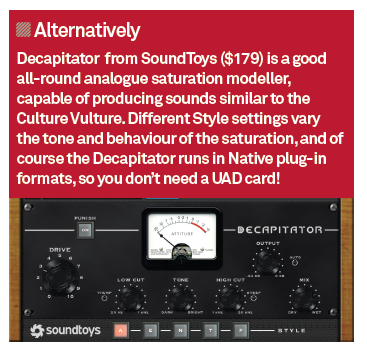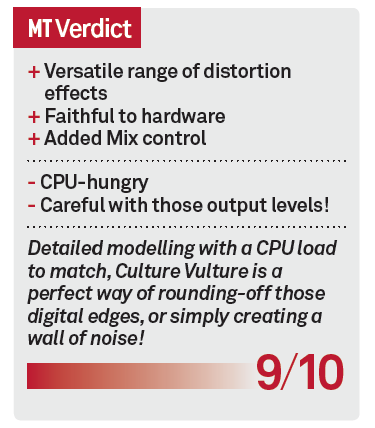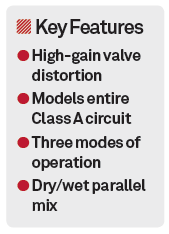Universal Audio The Culture Vulture Review
The ultimate valve-driven distortion hardware gets the UAD treatment. Mark Cousins plugs in… Details Price $299 Contact Source Distribution 020 8962 5080 Web www.uaudio.com Amazon.co.uk Widgets Over the last year or so Universal Audio has directed a lot of effort towards a timely refresh of many of their key plug-ins – such as the Pultec Passive EQ, […]

The ultimate valve-driven distortion hardware gets the UAD treatment. Mark Cousins plugs in…


Details
Price $299
Contact Source Distribution 020 8962 5080
Web www.uaudio.com
Over the last year or so Universal Audio has directed a lot of effort towards a timely refresh of many of their key plug-ins – such as the Pultec Passive EQ, Fairchild Tube Limiter and 1176 Compressor – arguably as a result of having more DSP processing power to play with. One of the key benefits of all these updates has been the improvement in modelling the device’s unique nonlinearities, or distortion in other words.
Therefore it’s a logical extension that Universal Audio has directed much of this recently acquired experience towards the ultimate hardware distortion box – Thermionic Culture’s Culture Vulture.
Cultural History
Introduced back in 1998, the Culture Vulture was designed as the ultimate audiophile distortion box, driven by Thermionic valves and a distinct lack of solid state components. As you’d expect, the hardware version produced a wide range of tones that became a hit with many sound engineers, from subtle valve-driven ‘warming’ effects, right up to complete sonic obliteration!
Ask any software engineer how difficult distortion is to model properly and you can see why Universal Audio took its time before attempting this beast!
In essence the Culture Vulture is somewhat akin to a big gain knob, but behind that simple façade sits a set of carefully interleaved controls. The two principle points of attention, therefore, are Drive and Output Level. Simply increase the Drive to start producing some form of distortion, matching this with a corresponding reduction in the Output Level.
The quality of the distortion is dictated by both the Distortion Type control – labelled T, P1 and P2 – as well as the Bias control, both of which vary the colour between soft saturation and the sound almost being completely destroyed by the amount of overdrive.

Gaining the Advantage
Arguably the most important control to master on the Culture Vulture is the Distortion Type. Starting with the Triode setting (T), it can be used to generate a smooth and musical collection of second-order harmonics, which are what most people attribute to the ‘warm’ sound of tube distortion.
The Triode setting, therefore, is a great way of adding warmth to a sterile digital recording without the output sounding deliberately distorted. Drums sound great, for example, with a touch of Triode adding body and energy, while vocals can be given some important extra bite to help cut through the mix.
Far more aggressive and unusual distortion can be found under the two Pentode modes (P1 and P2), which tend to favour third-order harmonics and sound great when you want a more deliberately ‘distorted’ sound, like some hard-edged drums or electric guitar.
All three modes can also be influenced by the Bias control, which varies between a ‘fatter’ distortion when you move the control counter-clockwise of its central position; and a more ‘starved’ distortion when you move the control clockwise. In P2 mode, Bias is at the heart of some of the most unusual distortion effects, almost verging on ring modulation-like treatments.
Pure Analogue
As is evident from both the sound and versatility of the Culture Vulture, Universal Audio has spent a lot of time modelling every last detail of the original hardware.
The significant cost, however, is DSP processing power, with just a single instance of the Culture Vulture using up to 36% of resources on our timid UAD-2 Satellite DUO. Of course, given the ability to ‘print-through’ the Culture Vulture as the front-end of an Apollo audio interface this might not be such an issue for some users.
Having been a long-term fan of using the Moog Multimode Filter plug-in like a distortion pedal, the addition of the Culture Vulture, and the versatility it offers, is a welcome new recruit to the fold. Certainly it’s hard to think of another plug-in that offers this level of authenticity and versatility in respect to valve-driven distortion, so if you’re a real overdrive junkie the Culture Vulture is not to be missed!




